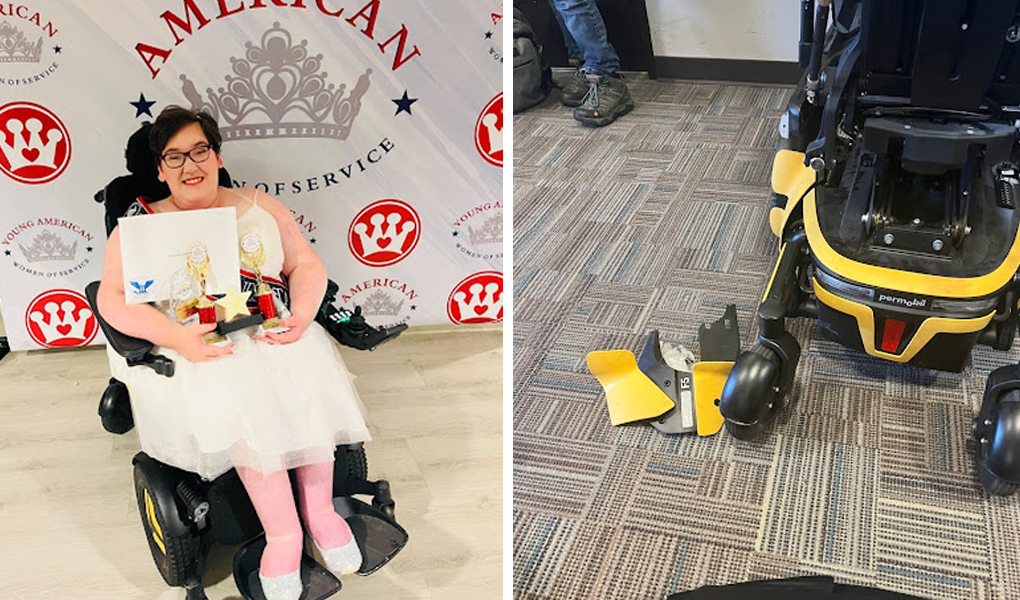If Janelle Fiesta didn’t live with a physical disability, she is certain she would be a flight attendant. The 27-year-old from Honolulu is an avid traveler whose eyes twinkle as she reminisces about trips to Disney Parks with her boyfriend, Antoine, and opportunities she’s had to connect with the global community of individuals living with her same neuromuscular condition.
But after the power-wheelchair she relies on for mobility was rendered inoperative by Hawaiian Airlines on a recent trip to Los Angeles, Fiesta doesn’t know when she’ll regain the confidence to fly again.

“It makes me really wary and paranoid about traveling because there’s always a risk that your chair is going to get damaged,” she said.
Fiesta travels with her backup wheelchair instead of the device she uses on a regular basis because of how frequently she hears of wheelchairs being damaged by airlines. “It’s unfortunate, but it’s what I have to do— I just can’t take the risk with my primary chair,” she said.
Even her backup chair is custom-built to ensure her comfort and safety, equipped with a variety of functions such as seat elevation, tilt and recline to maximize her mobility and independence. But despite taking precautions to wrap her wheelchair prior to the flight and remove the most fragile parts to carry into the cabin, on touchdown at LAX her worst nightmare became a reality.
“Everything seemed good until the moment when I turned on my chair and I started getting errors with my brakes.”
“‘Oh. That’s awkward’,” she recalls thinking, perplexed. “So, we tried doing the breaks again and it [still] didn’t work.”
After almost 30 minutes of troubleshooting at the gate, panic set in as Fiesta realized that she likely would not be driving out of the airport with a functioning wheelchair, sending her weekend plans for a fun California getaway spiraling into disarray.

Mobility devices handled like luggage, only worse
As hordes of travelers flock to airports around the country over the holiday period, disabled passengers face the added anxiety of how their device will be handled in transit. Reinforcing their fears further, a recent viral video posted to TikTok showing an American Airlines employee sending a wheelchair crashing to the tarmac prompting criticism from U.S. Transportation Secretary Pete Buttigieg and calls for an investigation into the incident.
This is totally unacceptable. We’ll be investigating. This is exactly why we are taking action to protect passengers who use wheelchairs. Everyone deserves to travel safely and with dignity. https://t.co/K5HO5QIWLK
— Secretary Pete Buttigieg (@SecretaryPete) November 20, 2023
More than 38,000 devices have been damaged, lost or delayed during domestic air travel in the U.S. in the past five years alone. Since a law requiring the Department of Transportation to publish data on mishandled wheelchairs took effect in December 2018, such incidents have occurred at an average rate more than twice that of mishandling of regular baggage.
Wheelchairs are loaded into the cargo hold, but unlike a typical suitcase in which the contents might be easily replaced, for each mishandled wheelchair there is an owner who has been denied their comfort, dignity and freedom with little-to-no hope of immediate restoration. For people living with long-term disabilities, mobility devices are often tailor-made to accommodate individual needs and can cost upwards of $30,000 in the case of a power-wheelchair such as Fiesta’s.
Any wheelchair won’t do
“I felt stripped of my independence,” Fiesta said, remembering the concerned looks of surrounding passengers waiting to board their onward flight as she sat “stranded” in her chair.
Equipped with a contact number to file a complaint with Hawaiian Airlines, Fiesta and her family left the airport, her boyfriend manually pushing her in her 300-pound wheelchair while she made frantic calls to local repair shops. They were first instructed to lodge a complaint in-person on the opposite side of the terminal, but couldn’t risk missing their pre-booked, wheelchair-accessible ground transportation.
The limited transportation options for power-wheelchair users were a compounding complication, she said: “I wouldn’t be able to get out of this airport [that] evening if I were to stick around.”
After numerous unanswered calls to local repair shops due to Veterans Day closures, the best she could manage was to secure an off-the-shelf manual wheelchair to be delivered to her hotel the following morning at her own expense. They padded the temporary wheelchair with pillows, towels and a makeshift board to increase the height of the backrest, hoping to recreate something close to the supportive seating system Fiesta typically relies on. She is unable to self-propel a manual wheelchair, but it was at least light enough for her travel companions to push for the duration of their stay.

In addition to attending the summit for spinal muscular atrophy, the muscle-wasting condition Fiesta was born with, she had planned on spending the weekend at Disneyland, savoring her favorite park snacks and admiring the festive décor. In spite of everything, she continued smiling through the frustration: “You go to Disney and you just want to explore… the sense of freedom was gone, [but] I tried to enjoy it as much as I could.”
As the alarming statistics suggest, Fiesta’s story is by no means the exception and disabled passengers and their assistive devices continue to be subjected to treatment that threatens their right to participate freely in air travel. Addy Loerzel, 17, has spina bifida and suffered a catastrophic loss of function when her wheelchair was totaled by Delta Airlines earlier this year.
“It makes me sad that Addy has to make that choice. We love traveling and I just wish we could get on an airplane and know that we would make it to our destination without any troubles,” said Addy’s mother Marisa Loerzel.
In extreme cases, the consequences of wheelchair damage can be grave, and Addy spent one month bedridden due to a pressure sore as a direct result of the incident. In 2021, disability advocate Engracia Figueroa died from injuries relating to her damaged wheelchair.

Baggage handlers, often with minimal training or lifting equipment, grapple with the weight of complex mobility devices while working against the clock to ensure the timely departure of an aircraft. To aid the process, many disabled passengers have taken to taping their own signage to their wheelchair, with messages ranging from “lift safely here [arrows]” to the desperate plea, “please don’t break my legs” accompanied by a photograph of the owner to elicit empathy and underscore the importance of transporting the device unscathed.
Deanna Thompson of Santa Rosa, California, was traveling with her service dog when the airline knocked a wheel off the scooter she depends on for mobility. For her, there’s a sense that these precautions can only do so much: “I wish we could just put it on the plane itself. But no, they put it down in baggage and [you] pray to God they don’t wreck it.”
The disability community has spent years rallying around the fight for more equitable access to air travel, but this year the movement was energized around the impending reauthorization of the Federal Aviation Administration, which would include several key provisions to improve the flying experience for passengers with disabilities. Originally scheduled for Oct. 1, 2023, the reauthorization has now been delayed for several months as part of efforts to avoid a government shutdown.
Among other policy changes for the industry, these provisions include rules on training standards for loading wheelchairs and scooters and a requirement for airlines to publish cargo hold dimensions online. The latter would permit passengers to assess the compatibility of their device with certain aircrafts, including whether the device would need to be stowed on its side, and, if necessary, obtain a refund for their ticket.
Airlines for America, the trade group representing the leading U.S. airlines, said in an email: “A4A passenger airlines signed a joint commitment last October and are continuing to take steps to improve accessibility and services for passengers with disabilities. Specifically, those airlines committed to supporting the continued study and development of safe and feasible aircraft accessibility features that broaden air travel opportunities for passengers with disabilities.”
On the upcoming FAA reauthorization, they added, “We look forward to continuing to work with Congress and industry stakeholders through the FAA reauthorization process on meaningful and realistic accessibility measures.”
The goal: wheelchairs in cabins, not cargo
Ultimately, the goal of many advocacy organizations and disabled individuals alike is to see aircraft cabins modified to allow passengers to remain in their wheelchair in-flight. For example, Delta recently unveiled the first concept for a “wheelchair-friendly” seat, igniting hope that a more accessible future of air travel could one day be a reality.
While the reality of wheelchairs within the cabin may be some way off, the FAA reauthorization could provide for investment in further studies to assess the feasibility of this gold-standard solution to air travel inaccessibility.
Michele Erwin, founder and president of All Wheels Up, a nonprofit organization advocating for accessible air travel, expressed cautious optimism at the prospect of wheelchairs being secured within the cabin. She said, “I think what we can see right now is it cannot happen today because we’re still working on the research and development and creating the standards… The FAA is currently creating those standards and so every day we’re further down the ball field of making it happen.”
For passengers like Fiesta, however, the immediate struggle persists. On returning home to Honolulu, she received no communication from Hawaiian Airlines despite repeated calls, emails and letters. She independently sourced repairs for the damaged wheelchair at her own cost but hopes that all costs relating to the mishandled device will eventually be reimbursed by the airline.
“It’s just radio silence,” she said at the time of her interview with Peninsula Press on Nov. 21.
Hawaiian Airlines declined to comment on the specifics of Fiesta’s case but contacted her swiftly after receiving a request for comment. (Fiesta was contacted in early December).
They said in a statement, “If [Hawaiian Airlines] is responsible, we will fix or replace devices in accordance with the [Air Carrier Access Act]. To minimize the impact on our guests, the Claims and Airport Operations teams work quickly to investigate the incident and determine the appropriate next steps. Rental devices, repairs, and/or compensation are provided based on the nature of each individual situation.”
As the FAA reauthorization looms and the disability community’s collective struggle for equitable access to air travel gains momentum, airlines are increasingly being pressured to face up to their responsibilities to disabled passengers like Fiesta.
She hopes that a brighter future could be on the horizon: “Living with a disability – nothing is really ever straightforward… but having wheelchairs [onboard] planes would be a huge game-changer.”

